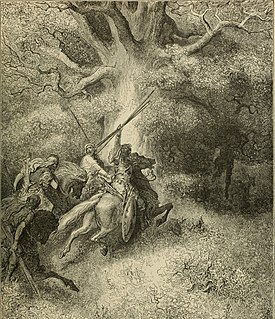Battle of the Wood of Ephraim
| Battle of the Wood of Ephraim | |||||||
|---|---|---|---|---|---|---|---|
| Part of Absalom's Revolt | |||||||
 Relief of Joab (front rider) riding on a horse to put an end to Absalom's princely rebellion | |||||||
| |||||||
| Belligerents | |||||||
| Forces of King David | Forces of Absalom | ||||||
| Commanders and leaders | |||||||
|
David Joab Abishai Ittai |
Absalom † Amasa | ||||||
| Casualties and losses | |||||||
| Unknown; Light | Unknown; Heavy | ||||||
According to 2 Samuel, the Battle of the Wood of Ephraim was a military conflict between the rebel forces of the formerly exiled Israelite prince Absalom against the royal forces of his father King David during a short-lived revolt.[1][better source needed]
Scholarly opinion is divided as to the historicity of the events in the Books of Samuel. Most scholars believe that the Books of Samuel contain a large amount of historical information, while there are some dissenters who view them as entirely fictional.[2]

Background
Absalom, the third son of King David of Israel, had been newly returned from three years in exile in Geshur for the murder of his half-brother, Amnon and received a pardon with some restrictions.[3] Later, he began a campaign to win the lost favour and trust of the people,[4] which was successful.[5] Absalom, under the pretense of going to worship at Hebron, asked King David permission to leave Jerusalem. David, unaware of his true intentions, granted it and Absalom left with an escort of 200 men. Upon arriving in the city, Absalom sent messengers to all the leaders and tribal princes throughout the empire to back him as king[6] Meanwhile, back in Hebron he continued to sacrifice under the guise that he was only there to worship God while still gathering officials and important people in the empire, growing his numbers and strength, including receiving the support of Ahithophel of Giloh one of the royal councilors. When News of Absalom's now open revolt in Hebron reached the royal Israelite court in Jerusalem[7] Upon learning of these developments, King David ordered the city and court evacuated, fearing that the rebel forces under Absalom would besiege.[8] He left with the entire Israelite royal house, as well as his elite Cherethite/Pelethite Royal guard, a mercenary force of 600 Gathites under their commander Ittai the Gittite. They marched to the Kidron valley and came to the bank of the Jordan river. They crossed leaving behind several spies and double agents to subvert Absalom and his conspirators and infiltrate their court and gather information on the rebel movements.[9][10]
Location
The tribe of Ephraim is associated with land west of the Jordan River (Joshua 16), but David had retreated to a city east of the Jordan, Mahanaim,[11] most likely to be identified with Tell adh-Dhahab ash-Sharqiyya on the south side of the Jabbok River. Most Bible geographers place the "Forest of Ephraim" east of the Jordan River, in the region also known as Gilead. This identification is bolstered by the statement that Absalom's army camped "in the land of Gilead"[12] as they prepared for battle against David.[13]
Battle
Absalom initiated the attack with his forces. He chose Amasa, one of Joab's kinsmen, as general, and marched out of Jerusalem into the land of Gilead. When David entered Mahanaim with his forces, as a result of his fame many warriors flocked to his aid, and passed before him to the battle,[14] as he stood at the gate of the city. David divided the army into three parts—one was to be led by Joab; one by Abishai; and the third by Ittai, the trusted friend and commander from Gath.
David then declared that he would head the army himself, but his soldiers would not allow David to risk his life. They asked him to remain in the city. When all was ready, David gave to the three Generals this parting injunction, "Deal gently, for my sake, with the young man, with Absalom." The two armies met in a forest of Ephraim. It was a great and terrible battle. The rebel forces were unable to maneuver because the thickness of trees, and their numbers were reduced by the underbrush of the forest.[15] The forces of Absalom were thus routed by the royal forces of David.

Absalom himself fled. As he was riding through the woods on his mule, he was caught by the long locks of his hair under the spreading branches of a large tree. Unable to free himself, he remained suspended, his mule had escaped. One of David's servants brought this intelligence to General Joab, who gave the order that Absalom be put to death and the royal troops disengaged immediately thereafter.
See also
References
- ^ LITERATURE. See the commentaries on the books of Samuel, Kings, Chronicles, and Psalms, and histories of the kingdoms of Israel and Judah, especially Wellhausen and Kittel. A sketch of the life and historical position of David from the modern Continental point of view will be found in G. Beer, Saul, David, Salomo, published by Mohr, Tubingen, 1906.
- ^ Andrew Knapp (19 November 2015). Royal Apologetic in the Ancient Near East. SBL Press. p. 162. ISBN 978-0-88414-075-7.
- ^ 2 Samuel 14:21, 14:23–24
- ^ 2 Samuel 15:1–5
- ^ 2 Samuel 15:6
- ^ 2 Samuel 15:9–10
- ^ 2 Samuel 15:13
- ^ 2 Samuel 15:14–15
- ^ "Espionage and the Jews". Haarezt. Elon Gilad. Nov 12, 2013.
- ^ 2 Samuel 15:27–29, 15:34–36
- ^ 2 Samuel 17:24
- ^ 2 Samuel 17:26
- ^ "Forest of Ephraim".
- ^ "David". www.Bibler.org.
- ^ 2 Samuel 18:8 NIV

